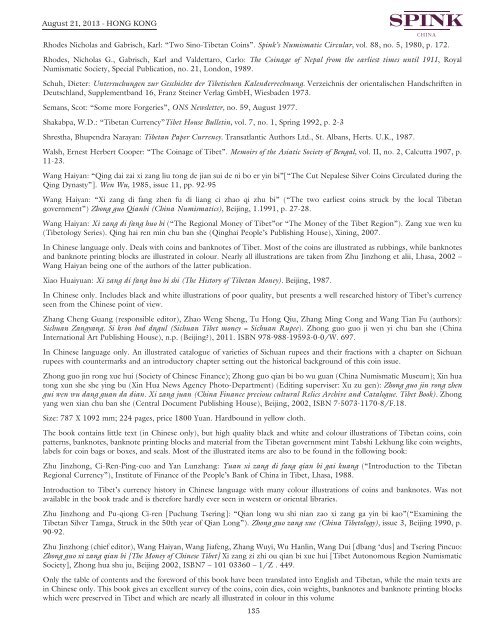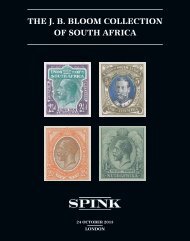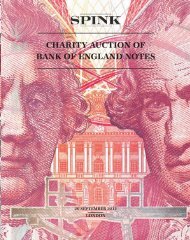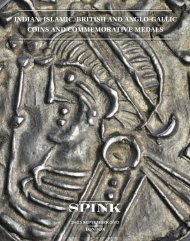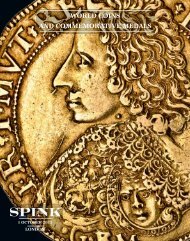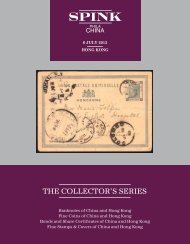Create successful ePaper yourself
Turn your PDF publications into a flip-book with our unique Google optimized e-Paper software.
August 21, 2013 - HONG KONGRhodes Nicholas and Gabrisch, Karl: “Two Sino-Tibetan Coins”. <strong>Spink</strong>’s Numismatic Circular, vol. 88, no. 5, 1980, p. 172.Rhodes, Nicholas G., Gabrisch, Karl and Valdettaro, Carlo: The Coinage of Nepal from the earliest times until 1911, RoyalNumismatic Society, Special Publication, no. 21, London, 1989.Schuh, Dieter: Untersuchungen zur Geschichte der Tibetischen Kalenderrechnung. Verzeichnis der orientalischen Handschriften inDeutschland, Supplementband 16, Franz Steiner Verlag GmbH, Wiesbaden 1973.Semans, Scot: “Some more Forgeries”, ONS Newsletter, no. 59, August 1977.Shakabpa, W.D.: “Tibetan Currency”Tibet House Bulletin, vol. 7, no. 1, Spring 1992, p. 2-3Shrestha, Bhupendra Narayan: Tibetan Paper Currency. Transatlantic Authors Ltd., St. Albans, Herts. U.K., 1987.Walsh, Ernest Herbert Cooper: “The Coinage of Tibet”. Memoirs of the Asiatic Society of Bengal, vol. II, no. 2, Calcutta 1907, p.11-23.Wang Haiyan: “Qing dai zai xi zang liu tong de jian sui de ni bo er yin bi”[“The Cut Nepalese Silver Coins Circulated during theQing Dynasty”]. Wen Wu, 1985, issue 11, pp. 92-95Wang Haiyan: “Xi zang di fang zhen fu di liang ci zhao qi zhu bi” (“The two earliest coins struck by the local Tibetangovernment”) Zhong guo Qianbi (China Numismatics), Beijing, 1.1991, p. 27-28.Wang Haiyan: Xi zang di fang huo bi (“The Regional Money of Tibet”or “The Money of the Tibet Region”). Zang xue wen ku(Tibetology Series). Qing hai ren min chu ban she (Qinghai People’s Publishing House), Xining, 2007.In Chinese language only. Deals with coins and banknotes of Tibet. Most of the coins are illustrated as rubbings, while banknotesand banknote printing blocks are illustrated in colour. Nearly all illustrations are taken from Zhu Jinzhong et alii, Lhasa, 2002 –Wang Haiyan being one of the authors of the latter publication.Xiao Huaiyuan: Xi zang di fang huo bi shi (The History of Tibetan Money). Beijing, 1987.In Chinese only. Includes black and white illustrations of poor quality, but presents a well researched history of Tibet’s currencyseen from the Chinese point of view.Zhang Cheng Guang (responsible editor), Zhao Weng Sheng, Tu Hong Qiu, Zhang Ming Cong and Wang Tian Fu (authors):Sichuan Zangyang. Si kron bod dngul (Sichuan Tibet money = Sichuan Rupee). Zhong guo guo ji wen yi chu ban she (ChinaInternational Art Publishing House), n.p. (Beijing?), 2011. ISBN 978-988-19593-0-0/W. 697.In Chinese language only. An illustrated catalogue of varieties of Sichuan rupees and their fractions with a chapter on Sichuanrupees with countermarks and an introductory chapter setting out the historical background of this coin issue.Zhong guo jin rong xue hui (Society of Chinese Finance); Zhong guo qian bi bo wu guan (China Numismatic Museum); Xin huatong xun she she ying bu (Xin Hua News Agency Photo-Department) (Editing superviser: Xu zu gen): Zhong guo jin rong zhengui wen wu dang guan da dian. Xi zang juan (China Finance precious cultural Relics Archive and Catalogue. Tibet Book). Zhongyang wen xian chu ban she (Central Document Publishing House), Beijing, 2002, ISBN 7-5073-1170-8/F.18.Size: 787 X 1092 mm; 224 pages, price 1800 Yuan. Hardbound in yellow cloth.The book contains little text (in Chinese only), but high quality black and white and colour illustrations of Tibetan coins, coinpatterns, banknotes, banknote printing blocks and material from the Tibetan government mint Tabshi Lekhung like coin weights,labels for coin bags or boxes, and seals. Most of the illustrated items are also to be found in the following book:Zhu Jinzhong, Ci-Ren-Ping-cuo and Yan Lunzhang: Yuan xi zang di fang qian bi gai kuang (“Introduction to the TibetanRegional Currency”), Institute of Finance of the People’s Bank of China in Tibet, Lhasa, 1988.Introduction to Tibet’s currency history in Chinese language with many colour illustrations of coins and banknotes. Was notavailable in the book trade and is therefore hardly ever seen in western or oriental libraries.Zhu Jinzhong and Pu-qiong Ci-ren [Puchung Tsering]: “Qian long wu shi nian zao xi zang ga yin bi kao”(“Examining theTibetan Silver Tamga, Struck in the 50th year of Qian Long”). Zhong guo zang xue (China Tibetology), issue 3, Beijing 1990, p.90-92.Zhu Jinzhong (chief editor), Wang Haiyan, Wang Jiafeng, Zhang Wuyi, Wu Hanlin, Wang Dui [dbang ‘dus] and Tsering Pincuo:Zhong guo xi zang qian bi [The Money of Chinese Tibet] Xi zang zi zhi ou qian bi xue hui [Tibet Autonomous Region NumismaticSociety], Zhong hua shu ju, Beijing 2002, ISBN7 – 101 03360 – 1/Z . 449.Only the table of contents and the foreword of this book have been translated into English and Tibetan, while the main texts arein Chinese only. This book gives an excellent survey of the coins, coin dies, coin weights, banknotes and banknote printing blockswhich were preserved in Tibet and which are nearly all illustrated in colour in this volume135


